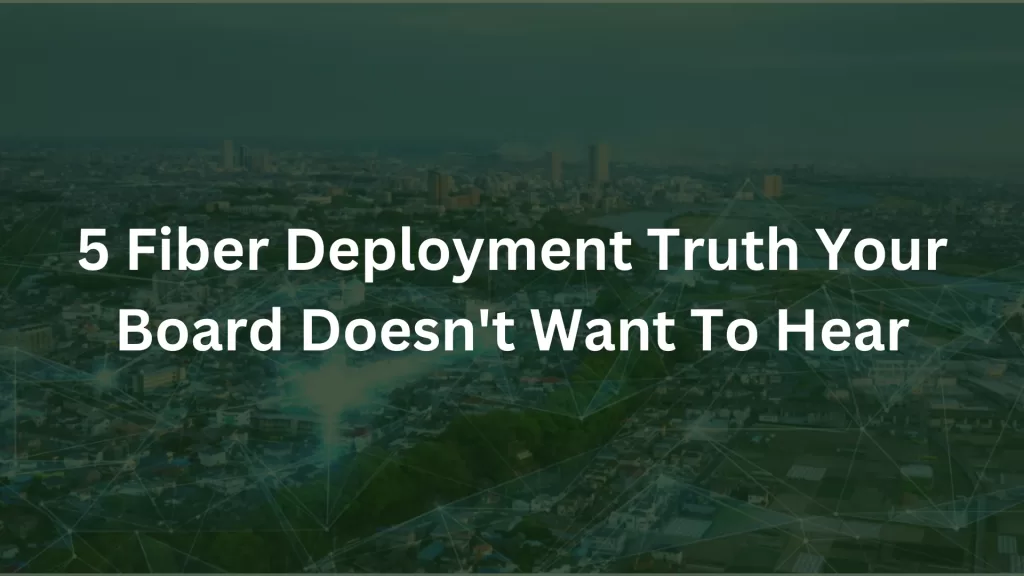
You’re sitting in your board meeting, and someone asks the big question:
“Why are we behind schedule again?”
The room gets quiet. Everyone looks at you. The charts don’t look terrible… until someone notices the small details. Costs are going up. Deadlines are slipping. People are complaining about slow internet. The board members are nice, but you know what they’re really thinking:
Why can’t we just finish this project already?
Sound familiar? You and all your peers else worry about the same thing. You want to give your community a fast, reliable network. But behind the scenes? Your team is tired, contractors aren’t doing their job, and surprise costs are popping up everywhere.
There are 5 things no one tells you about fiber deployment until it’s too late. Your board might not like hearing these things, but they need to if you want to avoid becoming another failed project.
Truth #1: Skipping the Design Step Will Cost You Big Time
We get it. You want to start building right away. Someone says, “Let’s get going, we’ll figure it out as we go!” But building without a solid plan is like building a house with no blueprints.
What happens? Crews run into gas lines, utility poles, or other underground pipes. They don’t know where to go, so they waste time and money fixing problems.
Quick Story:
There is an ISP we have heard about that was in such a rush to start digging. They skipped the design phase. Halfway through, they hit dozens of unmarked gas lines. Work stopped for weeks. Costs shot up by 37%, and the board was furious.
The real cost? Wasted money, delays, and frustrated people.
Truth #2: Cheap Contractors Will Cost You More in the End
A low bid looks great at first. The board loves it, and it seems like you’re saving money. But here’s what happens with the cheapest contractors:
- They cut corners on safety and quality.
- They make mistakes you have to fix later.
- They quit when the job gets too hard.
The result? You pay for the same work twice.
We saw one job where the contractor just walked off the site. Why? The project was harder than they expected, and their low bid didn’t cover the costs.
Lesson learned: The cheapest option often costs the most in the end.
Truth #3: Bad Communication Creates Most of the Problems
Here’s a surprising fact: 80% of fiber project delays come from poor communication.
- Engineers design a route, but the construction team doesn’t get the new plans.
- Someone makes a change in the field, but no one tells the rest of the team.
- The board asks for an update, but the numbers are outdated.
It’s like playing telephone with a project worth millions of dollars.
One city we know had this happen: The crew started drilling before permits were approved. Why? A project manager missed an email. That one mistake caused fines, delays, and a very awkward meeting with the board.
Truth #4: Ignoring Maintenance Will Hurt You Later
Everyone plans to build the network. But very few plan what to do after the network is live.
Fiber needs regular care, like:
- Checking ducts and handholes.
- Fixing small issues before they get worse.
- Troubleshooting when problems come up.
Without a plan, those small issues turn into big, expensive problems. And subscribers don’t care why it’s broken. They just want their internet to work. If it doesn’t? They leave.
Truth #5: Delays Are More Expensive Than You Think
Sometimes leaders say, “Let’s wait. There’s no rush.” But waiting costs more than you realize:
- Permits expire, and you have to pay to get new ones.
- Crews sit around, and you still have to pay them.
- Your competition moves in and grabs your customers.
We watched one co-op delay their project to “wait for better conditions.” Their competitor built the network first. By the time the co-op started, they had no customers left.
Why Most Projects Fail
The problem is how the industry works. Here’s what most companies still do wrong:
- They treat design, building, and maintenance like separate jobs instead of one big plan.
- They hire cheap contractors who don’t talk to each other.
- They focus on speed instead of quality.
The result? Failed projects, wasted money, and unhappy subscribers.
How Central States Utilities Solves This Problem
At Central States Utilities (CSU), we’ve seen these mistakes over and over. That’s why we do things differently. Our approach works because it’s simple, clear, and complete.
Here’s how we help:
- One Seamless Plan: We design, build, and maintain your network as one smooth process. No miscommunication, no missing steps.
- Experienced Crews: Our teams are highly trained and never cut corners. We focus on doing it right the first time so you don’t pay for mistakes later.
- Maintenance Plans: We build networks that are easy to maintain. That means fewer surprises and happier customers.
- Live Updates: You’ll always know where your project stands. We provide real-time progress, budget updates, and next steps.
Waiting Will Cost You More
If you’re dealing with delays, high costs, or unhappy subscribers, you’re not alone. But waiting won’t solve the problem. The longer you wait, the more it costs.
At CSU, we help leaders like you deliver fiber projects on time, on budget, and without stress. We’ve been in your shoes, and we know how to get it done right.
What To Do Next
If you’re ready to stop the delays and get your project back on track, let’s talk. Here’s what to do:
- Schedule a call with us.
- Tell us about your project and what’s holding you back.
- Let us show you how CSU can make your life easier.
The networks you build today will serve your community for years to come. Will you be the leader who got it done right? Or the one who waited too long?
Your board is waiting for answers. Let’s give them some.
